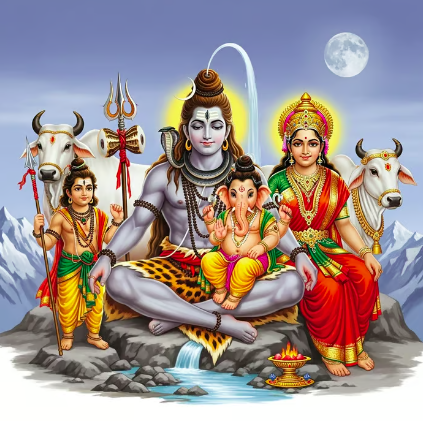
Sacred Flames: The Divine Science of Yagna and Havan in Vedic Dharma
Blog
Explore the spiritual and scientific essence of Yagna and Havan—timeless Vedic fire rituals that purify, protect, and uplift both the soul and environment.
747
Shivam Gangwar
8 min
Apr 07, 2025
🔱 The Role of Yagna and Havan in Vedic Traditions: Sacred Fire Rituals of Sanatan Dharma
Sanatan Dharma, the eternal way of life, is rooted deeply in rituals, symbolism, and spiritual practices. Among these, Yagna (यज्ञ) and Havan (हवन) hold a unique and sacred place. These ancient Vedic fire rituals have been performed for thousands of years, symbolizing selfless offerings, spiritual elevation, and cosmic balance.
🔥 What is Yagna?
Yagna is a Vedic ritual of offering oblations to the divine fire (Agni) while chanting mantras. It is not just a religious act but a spiritual and scientific process that aims to purify the environment, elevate consciousness, and invoke divine blessings.
The word "Yagna" comes from the root "Yaj", which means to worship, to offer, to unite.
🔥 What is Havan?
Havan is a simplified version of Yagna. It involves making offerings (Ahutis) into the sacred fire, often accompanied by Vedic or Puranic mantras. It is widely used in daily rituals, special occasions, and festivals across Hindu households and temples.
While all Havans are Yagnas, not all Yagnas are Havans. Yagna is broader and often more elaborate.
🕉️ Purpose of Yagna and Havan
- Purification of the Environment: The fire and herbs used in Havan purify the air, kill bacteria, and remove negativity.
- Spiritual Upliftment: The vibrations of mantras and the intention behind offerings raise spiritual awareness.
- Balancing Cosmic Energies: Yagna connects humans with natural forces (devas) like Agni, Vayu, Surya, aligning us with cosmic rhythms.
- Gratitude and Surrender: It symbolizes sacrifice and selflessness, offering back to the universe what we receive.
- Fulfillment of Desires: Different Yagnas are performed for health, prosperity, peace, rain, victory, progeny, and even liberation (moksha).
🪔 Components of a Yagna/Havan
- Agni (Fire) – The sacred medium that carries offerings to the gods.
- Samidha – Dried wood sticks used to feed the fire.
- Ghee (Clarified Butter) – Enhances the potency and aroma of offerings.
- Herbs & Grains – Like camphor, guggal, rice, barley, etc.
- Mantras – Powerful Sanskrit chants that energize the atmosphere and intention.
- Ahutis – Offerings made with each mantra recitation into the fire.
🌿 Types of Yagna
- Agnihotra – Performed at sunrise and sunset for environmental purification.
- Rudra Yagna – Dedicated to Lord Shiva for health and inner peace.
- Lakshmi Yagna – For wealth and prosperity.
- Durga Yagna – To remove negativity and invoke Shakti.
- Ashwamedha Yagna – A grand Vedic ritual once performed by kings for victory and sovereignty.
📖 Yagna in Scriptures
The Rigveda mentions Yagna as a cosmic sacrifice that sustains creation.
Bhagavad Gita (Chapter 3, Verse 10):
"Prajapati created humans with Yagna and said – through this, you shall prosper."
The Upanishads emphasize internal Yagna, i.e., offering ego, desires, and ignorance into the fire of wisdom.
🧘♂️ Inner Yagna – A Spiritual Interpretation
Beyond the physical ritual, Yagna symbolizes inner transformation:
Offering ego in the fire of self-discipline.
Sacrificing negativity to grow spiritually.
Serving society selflessly is also considered a Yagna.
🙏 Relevance in Modern Times
In today’s fast-paced, polluted, and stressful world, Yagna and Havan serve as:
Natural air purifiers
Stress relievers through mantra meditation
Tools for spiritual connection
Means to invoke divine energy in homes and communities
🪔 Conclusion
Yagna and Havan are not just rituals – they are a sacred bridge between humans and the divine. They teach us the values of self-sacrifice, purity, gratitude, and alignment with nature. Whether performed grandly or simply at home, their spiritual impact is profound and timeless.
Let us revive and respect these Vedic practices as a way to live harmoniously with the cosmos.
ॐ शांति: शांति: शांति:।
🔱 वैदिक परंपराओं में यज्ञ और हवन की भूमिका: सनातन धर्म की अग्नि साधना
सनातन धर्म, जो कि शाश्वत जीवन पद्धति है, उसमें रूपक, आध्यात्मिक साधना और अनुष्ठानों का विशेष स्थान है। इन्हीं में से एक अत्यंत पवित्र परंपरा है यज्ञ और हवन, जो आत्मोत्सर्ग, आध्यात्मिक जागरण और ब्रह्मांडीय संतुलन के प्रतीक हैं।
🔥 यज्ञ क्या है?
यज्ञ एक वैदिक अग्नि अनुष्ठान है जिसमें देवताओं को आहुतियां दी जाती हैं और वैदिक मंत्रों का उच्चारण होता है। यह केवल धार्मिक क्रिया नहीं, बल्कि एक आध्यात्मिक और वैज्ञानिक प्रक्रिया भी है जो वातावरण को शुद्ध करती है और चेतना को जागृत करती है।
"यज्ञ" शब्द "यज्" धातु से बना है जिसका अर्थ है – पूजा करना, अर्पण करना, एकजुट करना।
🔥 हवन क्या है?
हवन यज्ञ का सरल रूप है। इसमें भी पवित्र अग्नि में घी, जड़ी-बूटियां और अन्न की आहुतियां दी जाती हैं, लेकिन यह सामान्यतः घरों में, विशेष अवसरों पर या दैनिक पूजा में किया जाता है।
प्रत्येक हवन यज्ञ हो सकता है, पर हर यज्ञ हवन नहीं होता। यज्ञ का दायरा अधिक विस्तृत और विधिपूर्ण होता है।
🕉️ यज्ञ और हवन का उद्देश्य
- वातावरण की शुद्धि – अग्नि और औषधीय वस्तुएं वायुमंडल को शुद्ध करती हैं।
- आध्यात्मिक उत्थान – मंत्रों की ध्वनि और समर्पण भावना से आत्मिक उन्नति होती है।
- ब्रह्मांडीय संतुलन – यज्ञ के माध्यम से देवताओं (अग्नि, वायु, सूर्य आदि) की ऊर्जा से जुड़ाव होता है।
- कृतज्ञता और त्याग – यह जीवन के प्रति आभार और आत्मोत्सर्ग का प्रतीक है।
- इच्छाओं की पूर्ति – यज्ञ विशेष उद्देश्यों जैसे आरोग्य, धन, संतान, शांति या मोक्ष हेतु किए जाते हैं।
🪔 यज्ञ/हवन के प्रमुख घटक
- अग्नि – देवताओं तक आहुतियां पहुंचाने का माध्यम।
- समिधा – अग्नि को पोषण देने वाली लकड़ियाँ।
- घी – अग्नि को शुद्ध और सुगंधित बनाने के लिए।
- हवन सामग्री – जड़ी-बूटियाँ, गुग्गुल, चावल, तिल आदि।
- मंत्र – वेदों में वर्णित उच्च ऊर्जा वाले संस्कृत मंत्र।
- आहुति – प्रत्येक मंत्र के साथ अग्नि में दी जाने वाली वस्तु।
🌿 यज्ञ के प्रकार
- अग्निहोत्र – प्रातः और संध्या काल में किया जाने वाला यज्ञ।
- रुद्र यज्ञ – शिव की कृपा के लिए।
- लक्ष्मी यज्ञ – समृद्धि और धन की प्राप्ति हेतु।
- दुर्गा यज्ञ – शक्ति और नकारात्मकता से रक्षा हेतु।
- अश्वमेध यज्ञ – प्राचीनकाल में राजाओं द्वारा किया गया भव्य यज्ञ।
📖 शास्त्रों में यज्ञ
ऋग्वेद में यज्ञ को सृष्टि का आधार बताया गया है।
भगवद गीता (अध्याय 3, श्लोक 10):
“सहयज्ञाः प्रजाः सृष्ट्वा पुरोवाच प्रजापतिः।
अनेन प्रसविष्यध्वं एष वोऽस्त्विष्टकामधुक्॥”
(प्रजापति ने यज्ञ के साथ सृष्टि की रचना की और कहा – इसके माध्यम से तुम繁वति होगे)
उपनिषदों में आंतरिक यज्ञ की बात की गई है – जिसमें हम अपनी इच्छाओं, अहंकार और अज्ञान को ज्ञान की अग्नि में अर्पित करते हैं।
🧘♂️ आंतरिक यज्ञ – एक आध्यात्मिक दृष्टिकोण
अहंकार को त्याग की अग्नि में अर्पित करना।
नकारात्मक विचारों का दहन।
सेवा और परोपकार को यज्ञ मानना।
यह दृष्टिकोण दर्शाता है कि यज्ञ केवल अग्नि में अर्पण करना नहीं, बल्कि जीवन जीने की एक पवित्र पद्धति है।
🙏 आधुनिक युग में यज्ञ और हवन का महत्व
प्राकृतिक वायु शोधक – वातावरण को शुद्ध करते हैं।
मानसिक शांति और ध्यान – मंत्रों से मन स्थिर होता है।
आध्यात्मिक ऊर्जा का संचार – घरों और संस्थानों में सकारात्मकता आती है।
🪔 निष्कर्ष
यज्ञ और हवन केवल कर्मकांड नहीं, बल्कि ब्रह्मांड और आत्मा को जोड़ने वाला एक दिव्य सेतु हैं। ये हमें त्याग, पवित्रता, संतुलन और ईश्वर के प्रति कृतज्ञता की सीख देते हैं।
आइए, इस दिव्य परंपरा को समझें, अपनाएं और अगली पीढ़ी तक पहुंचाएं।
ॐ शांति: शांति: शांति:।





